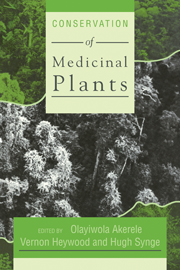Book contents
- Frontmatter
- Contents
- Contributors
- Preface
- Acknowledgements
- The Chiang Mai Declaration
- Introduction
- The Issue of Medicinal Plants
- Science, Industry and Medicinal Plants
- Techniques to Conserve Medicinal Plants
- Policies to Conserve Medicinal Plants
- Experiences from Programmes to Conserve Medicinal Plants
Preface
Published online by Cambridge University Press: 07 September 2010
- Frontmatter
- Contents
- Contributors
- Preface
- Acknowledgements
- The Chiang Mai Declaration
- Introduction
- The Issue of Medicinal Plants
- Science, Industry and Medicinal Plants
- Techniques to Conserve Medicinal Plants
- Policies to Conserve Medicinal Plants
- Experiences from Programmes to Conserve Medicinal Plants
Summary
Nearly all cultures from ancient times to the present day have used plants as a source of medicines. A considerable percentage of the peoples in both developed and developing countries use medicinal plant remedies and, according to the World Health Organization (WHO), the number is on the increase, especially among younger people. In the industrialized countries, consumers are seeking visible alternatives to modern medicine with its dangers of over-medication. The escalating cost of sophisticated medical care is another factor.
Over the last decade or so, WHO's Health Assembly has passed a number of resolutions in response to a resurgence of interest in the study and use of traditional medicine in health care, and in recognition of the importance of medicinal plants to the health systems of many developing countries. In answer to WHO's call, health authorities and administrators in developing countries have decided to take traditional forms of medicine more seriously and to explore the possibility of utilizing them in primary health care.
This great surge of public interest in the use of plants as medicines has been based on the assumption that the plants will be available on a continuing basis. However, no concerted effort has been made to ensure this, in the face of the threats of increasing demand, a vastly increasing human population and extensive destruction of plant-rich habitats such as the tropical forests. In some developing countries, users have to boil their plant medicines using precious wild-collected fuelwood, and so add insult to ecological injury.
- Type
- Chapter
- Information
- Conservation of Medicinal Plants , pp. xv - xviPublisher: Cambridge University PressPrint publication year: 1991
- 1
- Cited by



